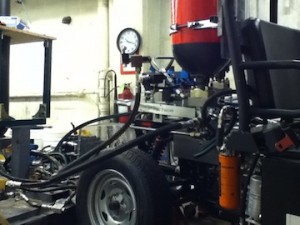UMN takes to the road with hydraulic hybrid vehicle
The University of Minnesota is the premier university for the Center for Compact and Efficient Fluid Power, a network of researchers, educators, students and industry leaders, funded by the National Science Foundation. Sixty-two industry sponsors across the country and internationally have been involved with the CCEFP since its inception in 2006. The university uses the CCEFP as a means to collaborate with fluid power programs at six other universities across the country. A consortium of four fluid power companies including the Eaton Corp., MTS Systems, Sauer-Danfoss and the Toro Company actively support the fluid power program, while several others have donated equipment.
The fluid power controls laboratory was founded in 1999 and is currently focused on the design of new pumps and valves, and on the development of human-friendly hydraulic systems, such as teleoperated hydraulic machines and human power amplifiers.
The program consists of mainly graduate level students, though there are a handful of undergraduates who take part in various projects. One such project is a hydraulic hybrid passenger vehicle. Thought of as an alternative to the costly and environmentally hazardous electric hybrids, the vehicle would offer greater power density than any electric hybrid.
“The big benefit of the hydraulic is you don’t need the big battery that the electric hybrid needs,” Tom Chase, director of undergraduate studies, said. “While they are doing wonderful things with battery technology, they still require some fairly hard-to-get materials.”

A hydraulic hybrid would also lack the large and expensive battery pack filled with toxic chemicals; instead it would use a longer lasting hydraulic accumulator. These accumulators tend to be bulky, but the technology exists to have a small storage capacity, as compared to a battery, and still maintain efficient operation.
Accumulators can leak the nitrogen used to keep the hydraulic fluid pressurized, but projects researching non-gas charged accumulators are also in the works.
The fluid power program at UMN is also working on projects that can help in more personal ways. Students and researchers are currently working on developing hydraulic and pneumatic systems that could be manipulated by a human in order to amplify that person’s natural strength.
The project is a collaborative effort between UMN and the fluid power program at Georgia Tech and aims to develop a device that can aid health care workers in transferring mobility-limited patients, including bariatric patients, from bed to wheelchair or from wheelchair to car.
The patient transfer device would run for a considerable length of time without the need to recharge and could lift up to 500 lbs. The device is compact and maneuverable, which would make it suitable for a home environment where space can be limited.
Research extends into the wind energy industry with more efficient parts and energy storage units for wind turbines.
“We have projects going on with hydrostatic transmissions for wind turbines,” Perry Li, lab director at the fluid power controls laboratory, said. “That is to replace the gearbox, which is the most unreliable component in a wind turbine.”
The lab is also developing ways to use hydraulics and pneumatics to provide energy storage for off-shore wind energy systems and a MEMS scale pneumatic valve. Designed for general use, the valve would replace pneumatic proportional valves with a smaller and more energy efficient device.
University of Minnesota
www.me.umn.edu

